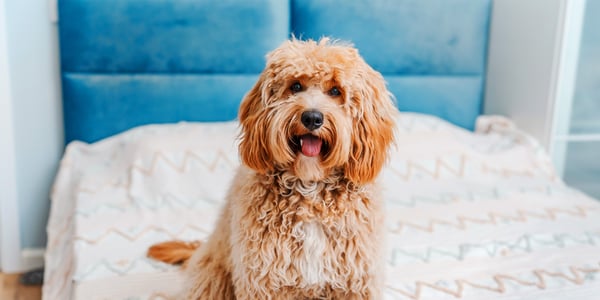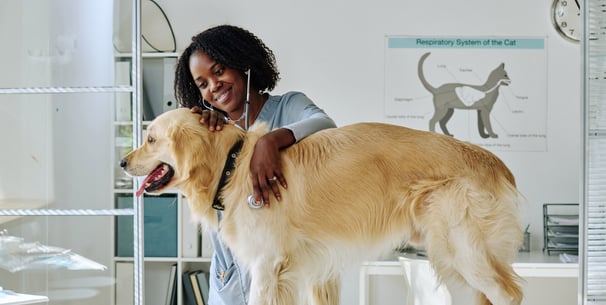Labradoodle Separation Anxiety - Can Labradoodles Be Left Alone?
Index:



Introduction
As a dog owner, you know the joy of welcoming a Labradoodle into your home. These clever mixes of Labradors and Poodles bring endless fun and cuddles.
But what happens when you need to step out? Many Labradoodle owners worry about Labradoodle separation anxiety.
Can Labradoodles be left alone without worry? We get it. It's tough seeing your pup distressed.
In this post, we'll explore the facts. We'll share tips to help your Doodle feel secure. Let's ease those concerns together.
Key takeaways
Provide mental stimulation and exercise to reduce destructive behaviour when you're away.
Tools like a crate or hiring a dog walker can make leaving your Labradoodle a smoother process.
If issues persist, consult a vet or animal behaviourist for tailored advice.
Understanding Labradoodle separation anxiety
Labradoodle separation anxiety hits hard for many families. These dogs crave company and they bond deeply with you.
When left alone, that bond can turn to stress. Think of it as your best friend after being apart for years. Dogs have a different concept of time and the loss of your scent starts their "missing you clock.”
They know how long you have been gone due to lack of scent and to them, your trip to the shops means "you are definitely never coming back this time, they just know it." which is kind of cute, but can cause issues in the home.
Just remember, Labradoodles love being by your side. But without prep, anxiety builds. We see this often in our community.
One comment we've seen is how an Australian Labradoodle howled at the door for hours when the pet parent left. It broke the owner's heart, and they had to return for cuddles. Guilt trips and puppy eyes can work wonders for them. But with simple steps, things improved.
What causes separation anxiety in Labradoodles?
Several factors play a role. First, lack of early training.Labradoodle puppies need gradual exposure to being solo.
Without it, they panic when separated from their owners.
Life changes matter too. Moving house or a new job can unsettle them. Even adult Labradoodles might struggle if they've always had constant company. Rescue dogs or those from busy homes face higher risks of ingrained behaviours.
Additionally, genetics count. Australian Labradoodles, a specific type of breed, often bond tightly to their family.
They were bred as service dogs, so independence isn't their strong suit. But remember, every doodle is unique. Some handle alone time like pros.
For more on the breed, check our Labradoodle breed guide.



Signs of separation anxiety in Labradoodles
Spotting trouble early helps. Watch for symptoms of separation anxiety. Your Labradoodle might pace the room or chew shoes in a frenzy.
They are clever dogs and you might notice they start to become anxious when you start to put on your shoes or coat. These are cries for help.
Common signs include:
Excessive barking or whining when you grab your keys.
Destructive behaviour, like scratching doors or ripping cushions.
House soiling, even if potty trained.
Drooling, panting, or trembling as you leave.
Following you room to room before departure.
If your dog seems fine until you're away, that's a clue to separation anxiety.
How long can Labradoodles be left alone?
Labradoodles can be left alone for short periods, like 1-5 hours, for adults. Pups need even less.
Aim for under 30 minutes at first. Adult dogs might manage longer hours with prep.
They will need toilet breaks just like people do, so leaving them for 6 hours or more without being let out is not recommended.
Labradoodle puppies are especially needy. Their world is new, so build it up slowly and with lots of praise.



Can Labradoodles be left alone when I work?
Yes, but with care. Labradoodles can be left alone if trained right.
They're not built for all-day solitude.
Unlike independent breeds, these pups want to be involved.
Smart dogs like them pick up routines fast. But skip the basics, and destructive behaviour follows.
For those who work full-time, options exist. A midday dog walker breaks the day up for them. Or try doggy daycare for social fun.
The key is balance. Leave your Labradoodle alone briefly at first and reward calm vibes.
Over time, they adjust. But forcing them to be alone for extended periods? That breeds stress. As per advice from breeders, prevention beats cure (Royal Australian Labradoodles).
The table below shows rough guides. Adjust for your dog's temperament.



Other ways to help your Labradoodle with separation anxiety
Don't fret. You can help your Labradoodle thrive but start with the basics. A good amount of exercise tires them out so a long walk generally means a chill pup at home. Mental and physical stimulation always works wonders.
Create a safe space for your Labradoodle
Set up a crate or a room with their bed and toys so they feel safe. Add a blanket with your scent. It says, "I'll be back."
Create a safe space like this, and they feel more secure.
When leaving your Labradoodle, leave chews or puzzles for their attention.
Playtime before you go helps too. We saw a comment online about a doodle who turned a pillow into confetti.
But with a puzzle feeder and placing their favourite treats in the corners of the room , they began to calm down and peace returned.
For more on this, head to our separation anxiety guide.
Training tips to reduce separation anxiety
As we have been saying, early training is gold. Use positive reinforcement and treats for quiet periods as they build trust and a positive association.
Gradually increase the time you're out after these positive spells. Start at five minutes, then build to an hour.
Quick list of steps to ensure your Labradoodle stays calm:
Practice departures without leaving. Jingle keys, then sit back down.
Start with short periods and gradually increase. Reward on return.
Ignore anxious bids for attention. Greet calmly when home.
Track progress and note successes and failures.



Are Labradoodles easy to train?
Absolutely. Labradoodles are quick learners. Again, for socialisation, expose them when young. Our guide to socialising a puppy has great starters.
If needed, hire a dog walker to take your pup out. Or dog walker services keep them moving.
Exercise and mental stimulation for Labradoodles
Labradoodles need activity. A tired dog rests easily. Aim for 60 minutes daily. Fetch or agility fits their energy levels. Mental stimulation like hide-and-seek sharpens minds and is fun for bonding with your pet.
Keep your Labradoodle engaged with toys and chews as well, and rotate them to stay fresh. This can help to cut anxiety when left alone.
If things seem severe, see an animal behaviourist. They tailor plans to your pet specifically. Also, your vet may recommend certain meds which can help.
Preventing separation anxiety in Labradoodle puppies
Catch it early. Labradoodle puppies learn fast and socialisation builds resilience so let them meet new folks and other dogs. Pup training classes can help if these are available in your area. Dogs require social interaction to help avoid clinginess.
Australian Labradoodles also benefit from routine. Feed, play, and rest on a specific schedule. This predictability soothes their mind. For breed basics, see our blog post 'What is a Labradoodle?'.
The role of breeders in early prevention
Go to your breeder and ask about any alone time they've had and if they had any practice.
At home, crate train gently and lovingly and make it fun with treats. Good breeders start strong. They expose litters to noises and solitude. Choose one who prioritises this. It sets your pup up for success.



When to seek professional help for your Labradoodle
Most cases improve at home. But if symptoms of separation anxiety worsen, act. Especially if a vet rules out health issues.
Managing separation anxiety may require professional help in this case.
Some signs it's time for professional help: Self-harm, constant escapes, or no eating.
An animal behaviourist or vet uses science-backed methods to reduce separation anxiety, so if you need help, reach out.
Labradoodle FAQs
Are Labradoodles prone to separation anxiety?
Yes, their affectionate nature makes them susceptible. But training helps.
How do I leave my Labradoodle alone for short periods?
Start small. Use toys and praise. Leaving a Labradoodle alone for short periods builds tolerance.
Can I use a crate for my Labradoodle?
Sure, if introduced positively. It's a safe space, not a punishment, so ensure they are happy and well-adjusted.
What if my Labradoodle shows destructive behaviour?
Address the root cause. Sometimes, more exercise and mental stimulation often fixes it.
Is doggy daycare good for Labradoodles?
Absolutely. It provides playtime and cuts alone time, creating a more content friend.
Waggel Pet Insurance
Need more help? You're in luck if you're a Waggel Pet Insurance member. Along with our excellent coverage, we offer access to a 24/7 online vet to answer all your sticky questions, especially if you need grooming assistance.
Not a member? Why not get a quote now and cover your furry friend for a range of illnesses, all while enjoying our amazing perks and rewards.
Want more like this?
Get updates from us with helpful info, advice, answers to frequently asked questions and much more.
Index:
- Introduction
- Understanding Labradoodle separation anxiety
- Signs of separation anxiety in Labradoodles
- Can Labradoodles be left alone when I work?
- Other ways to help your Labradoodle with separation anxiety
- Are Labradoodles easy to train?
- Preventing separation anxiety in Labradoodle puppies
- When to seek professional help for your Labradoodle
- Labradoodle FAQs
Related posts:
Get your quote
Along with our excellent coverage, we offer access to a 24/7 online vet to answer all your sticky questions.





